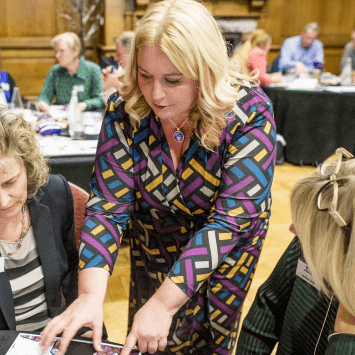Posted in Blog, Meetings by Jo North
How to Chair a Meeting with Skill and Confidence
The role of a chairperson in a meeting is pivotal to its success. Whether you’re overseeing a board meeting or an informal chat, effective chairing skills are essential for achieving the meeting’s objectives.
Online and In-Person Training for Meeting Chairs
One of our most requested training programs is Leadership Skills for Chairing Meetings Effectively.
Our program focuses on the leadership skills, including creative problem-solving, collaboration, influencing and communication, to chair effective and engaging live virtual and face-to-face meetings that support delivery of their organizational or project objectives. We customize the course content to meet our delegates’ specific requirements.

Purpose of this Article
Often we find that people are asked to chair meetings, but without any formal or structured training. This means that new chairs often base their approach on what they have observed other chairs doing. Of course, in many cases, those other chairs have most likely not received any training either.
Delegates who attend our progams are both new and experienced chairs. Even those people who have chaired for a long time wonder how effective their meetings are, and whether they are chairing well.
The purpose of this article is to share key tips and best practice on how to chair a meeting with skill and confidence.
Preparation is Key
The Agenda
How to chair a meeting with skill and confidence starts with a clear agenda. Draft an agenda with specific items for discussion and allocate a set amount of time for each. Make sure participants receive the meeting agenda in advance. This helps in setting the purpose of the meeting and provides a roadmap for the discussion.
Invite the Right People
The success of the meeting largely depends on having the right people in the room. Invite people based on the topic of the meeting. Be sure participants are well-informed and prepared to contribute useful ideas and solutions.
Logistics
Consider whether the meeting will be an online meeting or a face-to-face meeting. In the era of remote working, virtual meetings are common but require special attention to details like background noise and breakout rooms.
Have a look at my guides to leading meetings on Zoom, and using breakout rooms in Microsoft Teams.
Start Strong
Opening Remarks
At the start of the meeting, briefly summarize the objective and agenda. Good practice involves laying down ground rules and meeting rules, such as a ban on mobile phones or the procedure for raising points.
Body Language and Tone
Your body language and the tone you set can encourage open discussions and active listening. A good chairperson is approachable and impartial, allowing different points of view to be heard.

Master the Flow
Time Management
Your chair’s job involves strict time management and pace. A timed agenda helps to ensure that there’s enough discussion time for important issues, without letting the meeting drag on.
Active Listening
The art of active listening helps you recognize good points when they arise. Acknowledge contributions and steer the conversation towards actionable results.
Direct the Conversation
The most effective way to keep a meeting on track is by redirecting off-topic discussions. If an interesting but irrelevant point comes up, suggest it be added to the agenda for a future meeting.
Key Interactions
Online Tools
For virtual meetings, utilize the chat function for side conversations or to compile questions. If the discussion becomes too multi-faceted, breakout rooms can be used for smaller, focused discussions.
Wrapping Up
Summarizing and Next Steps
Towards the end of the meeting, summarize key points and action items. Make clear decisions on what needs to happen next. The chair should ensure that these action points are noted for follow-up.
Future Meetings
Before concluding, bring up the next agenda item: the date and focus of the next meeting. This helps keep the momentum going and gives participants something to prepare for.
Final Remarks
Good meetings end with a succinct wrap-up, leaving enough time for any last-minute contributions. Thank everyone for their attendance and contributions, setting a positive tone for future meetings.

How to Chair a Meeting: Advanced Chairing Techniques
Rotating Chairs: The Pros and Cons
In some organizations, the role of the meeting chair rotates among participants. This can invigorate meetings with new ideas and perspectives. However, this approach may disrupt the usual practice and tone of the meeting, requiring the new chair to quickly adapt.
Digital Tools for Efficiency
Leverage technology for a successful meeting today. Virtual whiteboards can capture much information in a clear way, aiding the flow of discussion. Polling features can also offer a quick way to gather opinions on a specific agenda item, making final decisions easier.
“Parking Lot” Method
When discussions veer off-topic but bring up important points, use the “Parking Lot” method. This is a dedicated space where off-topic or future agenda items are “parked” for future discussion. This ensures that the most important items of the current meeting are prioritized.
Zone-Based Meeting Rooms
When chairing in a large physical meeting room, consider the concept of ‘area chairs’. These are individuals who can help manage discussions in different zones of the room, ensuring that voices are heard evenly across the space.
The “Five-Minute” Rule
If the meeting is dragging into a long meeting, employ the “Five-Minute” rule. Essentially, allocate the last five minutes of any agenda item for summarizing and agreeing on next steps. This minimizes time overrun and makes for effective chairing.
The After-Meeting Summary
At the end of a meeting, an often overlooked yet important point is the after-meeting summary. Distribute meeting minutes as soon as possible. Compare the objectives and outcomes to those of the last meeting to show progression or areas that need focus.
Open Question Techniques
To solicit more than just ‘yes’ or ‘no’ answers, use open questions. For example, instead of asking, “Do we all agree on this?” ask, “What are your thoughts on this?” This encourages useful contributions and a diverse range of points of view.
You’ll find suggestions for great open questions for your meetings here.
Informal Pre-Meetings
For especially complex issues, holding an informal pre-meeting with key stakeholders can offer a way to explore possible solutions ahead of the official gathering. This isn’t a replacement for the full meeting but can help set the stage for more focused discussions.
Addressing Sensitive Topics
If you know that a topic might be contentious, introduce it as the first item. This is the best way to ensure it gets the attention it deserves before fatigue sets in. Frame the issue in the context of the objective of the meeting to keep the discussion on track.
Summary of Advanced Chairing Tips
By employing these advanced tips, you’ll not only facilitate a successful meeting but also command respect from your team. The outcome will be meetings that are more effective, inclusive, and productive.
To chair meetings like a pro, consider implementing some advanced techniques. Opt for a rotating chair system to infuse new perspectives, but be mindful that it might take some time to adapt to varying styles. Before formal gatherings, hold an informal meeting with key players to iron out complex issues and save much time later. Focus on creating a secure environment for all participants. Always distribute a draft agenda well in advance so that meeting participants can prepare, as this helps in effectively managing a lot of information. Lastly, encourage diverse points of view by using open questions, ensuring a more comprehensive discussion.
How to Chair a Meeting Effectively: Tips and Takeaways
- A great chair is well-prepared and establishes a clear agenda.
- Effective meeting chairing involves active listening and impartiality.
- Virtual meetings have their own challenges; be ready to adapt.
- Time management is crucial; an overrun meeting can lose focus and dilute the effectiveness.
- Successful meetings end with clear action points and plans for the next meeting.
By mastering these principles, you’ll not only conduct productive meetings but also ensure a successful outcome. The skills you acquire can be adapted to any meeting context, from board meetings with senior board members to casual online discussions.
So, the next time you chair a meeting, whether it’s a high-stakes board meeting or an informal gathering, use these top tips to guide you to success.
Next Steps
If you’ve found these tips helpful, head over to my detailed articles on How to Run Effective Leadership Team Meetings and 25 Tips for a Really Collaborative Team Meeting.
And of course, please do contact me direct here if you’d like to know more about our Leadership Skills for Chairing Meetings Effectively live online or in-person training program.


